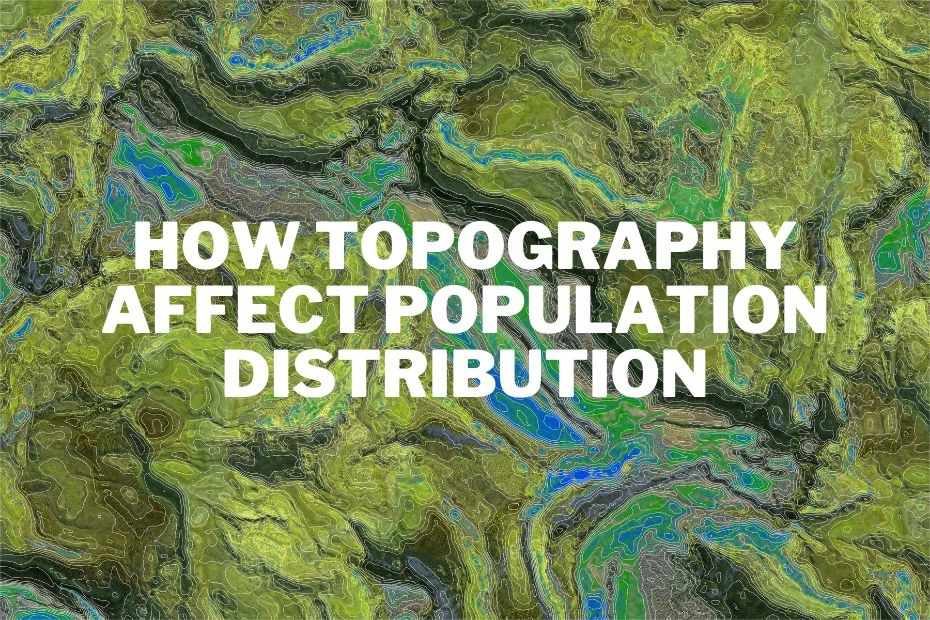Topography can affect the population distribution of a place, as it determines how easy or difficult it might be to live there. The distribution of population is affected by the topography of an area as well as other factors. The types of surfaces can affect how people move through a place and the distances they are willing to travel to work, school, and recreation. Plains areas tend to have higher populations than mountainous areas because it is easier to travel around; however, there is often not much land available for construction and production.
For example, people living in mountainous regions have more difficulty travelling from one valley to another due to the extreme slopes and elevation changes involved, so they often live in tightly packed communities near a mountain pass. In this article, We will discuss more about How Topography affect population distribution?.
Introduction:
Many people do not realize that topography has a significant impact on population distribution. In many parts of the world, the populations are concentrated near the coastlines or at lower altitudes where food is more easily grown and water can be obtained from rivers and lakes.
How Topography Affect Population Distribution?
Location is more than just where one resides, it is a complex combination of factors including climate, topography, resources, and proximity to markets. The history of the earth’s geologic events has played an integral role in shaping our environment today.
Mountains offer protection against harsh winter weather, however, their steep slopes do not allow for convenient access to life-giving rivers or fertile floodplains. Wetlands are lowlands that are susceptible to floods and tropical storms.
Topography often dictates the types of animals that can live in a particular area. For example, in the tropics, most mammals are adapted to tolerating hot temperatures and having limited access to water.
Topography And Population Distribution
Population distribution is the pattern in which people are distributed across a particular area of land. Topography, or terrain, includes the physical features of the earth’s surface, such as slopes and valleys. The distribution of population can depend on topography, for instance where there is a valley, populations will cluster towards the bottom because it is easier to live there.
Areas with flat terrain are more densely populated than areas with steep or mountainous terrain. This causes the population to be concentrated in lower regions, while sparsely populated in higher regions.
This is due to difficult access to resources in higher elevations, where there are fewer people for natural resources to support.
Physical Factors That Influence Population Distribution
Many physical factors affect population distribution. Topography is one of the many physical factors that have a strong impact on population distribution as it influences access to resources such as food and clean water.
One of the most prominent examples of how topography affect population distribution is in developed countries such as those in Europe and North America. These developed countries have higher populations because they are located on flat land.
#1. Climate
Climate change is an issue that affects both population distribution and migration patterns. It is thought that the coastal areas will be hit the hardest because of increased flooding, which can also lead to decreased availability of freshwater. Additionally, there may be more extreme weather-related events in these areas.
Over the past few centuries, a number of factors have influenced population distribution. One factor is climate, which has a significant impact on human settlement. This is because people have adapted to live in regions with climates that are conducive for their lifestyles and from where they can gain the supplies they need to survive.
Climate influences population distribution because people tend to migrate where it’s more comfortable, which depends on their culture, location, etc.
#2. Landuse
The human population distribution reflects the Earth’s natural environment and the constructions we have made. Location, climate, and topography all play a role in determining where people reside.
Population distribution in the United States has been shaped by a variety of natural and man-made factors. The most significant of these is topography.
When it comes to deciding where people live, altitude and climate play an important role. For example, people living in colder climates such as Alaska tend to cluster in lower regions with warmer weather such as Florida.
#3. Basic Needs
As population distribution is influenced by basic needs, population density is significantly impacted by the topography of an area.
For example, in areas where land is flat, population density is considerably high. Furthermore, the topography of an area can influence the distribution of population-based on basic needs, such as the availability of water.
#4. Geography
Countries on different continents often have significantly different populations because of their geographical settings.
For example, Russia has a population of 144 million people while Canada has 38 million people. These disparities are the result of Russia’s harsh climate and limited natural resources that make agriculture very difficult to cultivate whereas Canada has an abundant amount of fertile land with many rivers which produce many food crops.
#5. Quality of Soil
If an environment is not conducive to humans or their crops, then the people living there will be driven away. The quality of soil is a key factor in determining an area’s suitability for human settlement.
The best examples of this are the Great Plains of North America and the Andean Plateau in South America.
Factors Affecting Population Distribution: Visuals
Conclusion:
Topography has played a role in influencing population distribution for nearly all of human history. With the advent of technology, populations have been able to inhabit regions that were inhabitable before. However, there are still places that remain uninhabited because of topography.
